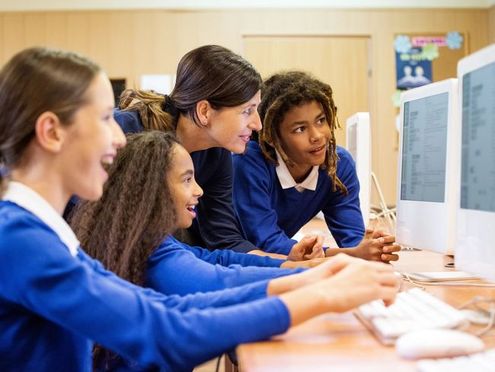During the pandemic, schools and educators had to adapt quickly to the move from in-person learning to remote learning - this meant the rapid increase of educational technology in the classroom. Even in the return to face-to-face learning, it doesn’t seem like edtech is going anywhere.
Educators agree that literacy is an essential skill in today's world and, in combination with the most effective education technology, literacy skills have the potential to rocket. Education technology can revitalise the way in which educators teach literacy in their schools by offering a wide range of engaging content that makes literacy more appealing and rewarding to learners. While teachers often do not have the time to personalise their teaching to each child, technology uses intelligent algorithms to differentiate between every student - such as with Bedrock Learning’s Alpha test and holistic assessment.
However, every part of educational technology has its own unique benefits. This article will discuss the ways in which you can use technology to improve literacy in your classrooms.
Educational technology gives every learner an opportunity to thrive.
1. Word Processing Software
Word processing software creates consistent, easy-to-read work that encourages the development of literacy. When using word processing software, learners' work is more legible for teachers, making it easier to mark. As well as this, it’s much more difficult to lose a document than it is to lose a flimsy sheet of paper.
Disadvantages that some learners may face, such as slow writing speed or poor handwriting, are diminished through the use of word processing software. In a world that increasingly relies on technology for success, weaknesses such as poor handwriting are becoming less and less relevant to the world beyond education - using educational technology in the classroom better mirrors the expectations of life, saving teachers time and helping learners succeed.
Word processing software also increases convenience as it offers mobility; writing, editing and publishing work is a faster process overall.
2. Voice Recognition Technology
Voice recognition technology can optimise education technology platforms by enhancing the accessibility of education through captioning in real-time. While this has benefits for every learner, this is especially helpful for learners who are hard of hearing or have special educational needs, such as attention deficit disorders and dyslexia. Implementing voice recognition technology makes online learning more inclusive for all.
It is also helpful to those with English as a second language as they can practise their speech and pronunciation. It also makes learning easier for students who struggle with writing or handwriting. Voice recognition is a great way to increase engagement from learners and provide evidence of understanding.
3. Spelling and Grammar Correction Software
Using spell-check software can benefit learners. Spell-check software helps learners produce more accurate work by correcting their spelling and grammar as they write. There are some instances where the teacher may want to check a learner’s understanding of a piece of content, and does not particularly mind if the writing is grammatically correct - for instance, in cases of learners with dyslexia. In these circumstances, the use of spell-check helps the teacher understand learners’ confidence level with new concepts better.
However, the use of spell check and grammar can end up letting the technology do all the work without the learner understanding the content themselves and working independently from the help of a computer can then become more difficult. A response to this would be to use text edit or word processing software where automatic corrections are disabled. This means that, when a word is spelt incorrectly, learners must manually check for the correct spelling - this gives them a chance to encounter the correct spelling repeatedly and think consciously about it, improving their accuracy in the long term.
4. Text-to-Speech Technology
Text-to-speech is an assistive technology that reads digital text aloud. With a click of a button or a touch of a finger, text-to-speech technology can take the words on the screen and convert them into audio. This has proven to be very effective as it allows the students to focus on the content rather than the act of reading. This results in a better understanding of the material and a more solidified understanding of literacy.
Text-to-speech software is also beneficial when teaching learners to proofread their work. When listening to written work read aloud, it becomes much easier to hear spelling and grammar mistakes, as well as instances where the flow of a paragraph feels unnatural. Incorporating text-to-speech technology into your lesson plan helps learners become accustomed to reading their work aloud before submitting it, improving their communication skills.
5. Interactive Whiteboards
Interactive whiteboards can accommodate different types of learning styles, and can integrate different learning styles into one lesson: for instance, seeing, hearing, writing and touching. The combination of these styles helps new information be understood more effectively. As well as this, using an interactive whiteboard rather than a regular whiteboard has the potential to make lessons more fun and engaging; for example, incorporating touch-screen literacy games, allowing learners to drag and drop responses, or even hosting online quizzes learners can join from their mobile phones.
6. Vocabulary-Enhancing Video Games
Video games provide an excellent environment for students to improve their vocabulary. Some might view video games as having quite addictive qualities, which can put teachers off using them in the classroom - however, the engaging elements of video games can be a major strength when applied to something productive, such as improving literacy. These gamified elements work to keep learners motivated.
Characteristics such as visuals, music, storyline, gameplay, and characters make video games attractive to a considerable amount of people. In fact, they are considered a relatively new way to promote literacy and vocabulary development. Similar to the way we use interactive whiteboards in the classroom, video games tailored to the development of vocabulary can allow students to combine learning styles like seeing, hearing, touching and speaking in video games at home to solidify the learning of new vocabulary.
7. Reading Software
Reading software is designed to take a print book and make it digital, such as on a Kindle or an app such as Audible. Not only does this make books more portable for learners, and therefore less easily forgotten, but it also unlocks ways that the text of a book can be changed to make reading it more accessible - for example, changing the background cover of a page, increasing the size of the text and using a dyslexia-friendly font.
Using assistive reading software is a cost-effective way to encourage less confident readers - it may be the case that the factors holding your learners back from loving to read could be related to accessibility and special educational needs. Making the process of picking up a book and beginning to read quicker and simpler makes it more likely your learners will continue to do it, improving their literacy.
8. Blogs and Articles for Teacher Inspiration
Coming up with new and exciting ideas for lesson activities and creating new ways to help learners develop their reading and literacy skills is difficult! Writing and reading blogs and articles are a great way for teachers to share their knowledge and ideas with each other. Seeing recommendations for literacy activities, first-hand accounts of what works and what doesn’t and becoming part of an online community can help educators to develop their own teaching.
Of course, we wouldn’t be able to recommend blogs without recommending Alex Quigley (The Confident Teacher) and David Didau (the Learning Spy). Much of their research and blog content has formed the foundations for literacy improvement and disciplinary literacy today. If you’re looking for ideas to inspire your teaching, start here.
As well as this, blogs such as Learning From My Mistakes (especially good for newly qualified teachers) and Teacher Toolkit are great for inspiring your lesson planning - but many teachers have their own blogs. Why not start your own?
9. Podcasts for Literacy Development
Podcasts are all the rage and have a wide range of topics for learners to explore. Literacy development can occur without the learner even realising. Listening to others can encourage literacy development without learners even realising. Podcasts are convenient when on the move and can be played at home, in the classroom or on the go. They can be vividly entertaining for children and can spark their imagination whilst developing their knowledge.
Here are our recommendations:
- But Why: A Podcast for Curious Kids - https://podcasts.apple.com/podcast/1103320303
‘But Why’ is a show led by kids. They ask the questions and we find the answers. It’s a big interesting world out there. On ‘But Why’, they tackle topics large and small, about nature, words, and even the end of the world.
- The Alien Adventures of Finn Caspian: Science Fiction for Kids - https://podcasts.apple.com/gb/podcast/the-alien-adventures-of-finn-caspian-science-fiction/id1139672164
The Alien Adventures of Finn Caspian is a serialised science-fiction story for kids, told in 15-20 minute episodes for parents to put on when driving around town, or to marathon on road trips, or to bond over before bed.
- Puffin Podcast: Mission Imagination - https://podcasts.apple.com/gb/podcast/puffin-podcast-mission-imagination/id1506190195
The podcast invites young listeners into a different magical world every week - from weather-brewing workshops to magical underwater worlds and fun fairs, listeners will be taken on an immersive journey to celebrate the Power of Imagination. A new episode drops every Wednesday. Have your pen, paper and notebook ready to scribble any story ideas of your own along the way.
- Greeking Out from National Geographic Kids - https://podcasts.apple.com/gb/podcast/greeking-out-from-national-geographic-kids/id1483233279
The ‘Greeking Out’ podcast recalls some of the greatest stories ever told: stories of gods and goddesses, monsters, and heroes! Enjoy this kid-friendly retelling of classic ancient Greek myths, perfect for the whole family.
- The Teacher’s Tool Kit For Literacy- https://podcasts.apple.com/gb/podcast/the-teachers-tool-kit-for-literacy/id1536825174
The perfect podcast for motivated teachers and school leaders who want the latest tips, tricks and tools to inspire their students and school community in literacy learning.
10. Vocabulary and Literacy Apps
Bedrock Learning leads the education technology industry with innovative vocabulary and literacy curricula.
When it comes to developing a learner’s vocabulary, grammar and overall literacy all in one place, Bedrock Learning is ideal. Bedrock Learning provides great opportunities for learners to improve their literacy through reading and writing practices, using multimedia and personalised learning to create a holistic approach to literacy learning. By harnessing the power of technology, Bedrock gives every learner the opportunity to thrive. We have transformed the way vocabulary instruction is regarded and delivered across the curriculum. Bedrock is a platform built with a deep understanding of what works for learners and teachers.
Our interactive learning sequence uses learner-friendly descriptions, images, synonyms, antonyms and writing opportunities to make sure every learner masters new, ambitious vocabulary. We provide live parent and teacher dashboards that reveal the progress and engagement of learners. We take pride in introducing learners to a wide range of engaging texts, helping to increase cultural capital while they develop their literacy. All content, including feedback, is human narrated, and marking is instant - not only does this help to increase learners’ independence when improving literacy, but it saves teachers much-needed time.
With bespoke curricula in vocabulary, grammar, GCSE English and disciplinary literacy, Bedrock Learning proves that technology can help educators improve literacy by providing an all-inclusive approach to explicit literacy instruction. Why not give it a try at your school with our free trial?




